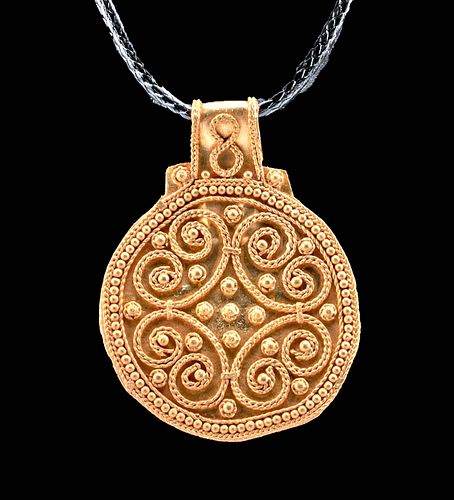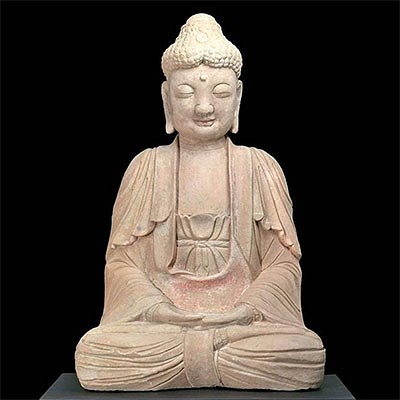9th C. Viking Gold Bracteate Pendant
Lot 49a
About Seller
Artemis Fine Arts
686 S Taylor Ave, Ste 106
Louisville, CO 80027
United States
Selling antiquities, ancient and ethnographic art online since 1993, Artemis Gallery specializes in Classical Antiquities (Egyptian, Greek, Roman, Near Eastern), Asian, Pre-Columbian, African / Tribal / Oceanographic art. Our extensive inventory includes pottery, stone, metal, wood, glass and textil...Read more
Categories
Estimate:
$5,000 - $7,500
Absentee vs Live bid
Two ways to bid:
- Leave a max absentee bid and the platform will bid on your behalf up to your maximum bid during the live auction.
- Bid live during the auction and your bids will be submitted real-time to the auctioneer.
Bid Increments
| Price | Bid Increment |
|---|---|
| $0 | $25 |
| $300 | $50 |
| $1,000 | $100 |
| $2,000 | $250 |
| $5,000 | $500 |
| $10,000 | $1,000 |
| $20,000 | $2,500 |
| $50,000 | $5,000 |
| $100,000 | $10,000 |
| $200,000 | $20,000 |
About Auction
By Artemis Fine Arts
Feb 18, 2021
Set Reminder
2021-02-18 10:00:00
2021-02-18 10:00:00
America/New_York
Bidsquare
Bidsquare : Exceptional Antiquities, Asian, Ethnographic
https://www.bidsquare.com/auctions/artemis-gallery/exceptional-antiquities-asian-ethnographic-6373
Museum-worthy examples of Egyptian, Greek, Roman, Etruscan, Near Eastern, Far East / Asian, Pre-Columbian, African / Tribal, Oceanic, Native American, Spanish Colonial, Russian, Fossils, Ancient Jewelry, Fine Art, so much more! Artemis Fine Arts info@artemisfinearts.com
Museum-worthy examples of Egyptian, Greek, Roman, Etruscan, Near Eastern, Far East / Asian, Pre-Columbian, African / Tribal, Oceanic, Native American, Spanish Colonial, Russian, Fossils, Ancient Jewelry, Fine Art, so much more! Artemis Fine Arts info@artemisfinearts.com
- Lot Description
Northern Europe, Viking, ca. 9th to 10th century CE. A stunning 86.62% gold bracteate pendant, equivalent to 20K+. The surfaces of both the circular face and the integral loop above are decorated with mesmerizing granulated and filigreed motifs of interlocking curls and bosses, the loop with a figure eight or alternatively infinity symbol as well. In addition, the circular face is surrounded by a lovely border of beaded and rope-patterned filigree motifs, while the loop is bordered by a rope-patterned filigree motif and flanked by two petite sections that are graced by central granules. Pendants like this example were worn around the neck or sewn onto clothing as a type of amulet for protection or good fortune. Gold quality: 86.62%, equivalent to over 20 karat. Weight: 5.4 grams. Size: 1.375" L x 1.1" W (3.5 cm x 2.8 cm); cord measures 20" L (50.8 cm)
Filigree and granulation are among the oldest goldsmithing techniques. The techniques involved include twisting silver wires and soldering incredibly tiny beads comprised of the same precious metal onto the surface of the piece of jewelry. This very complicated technique requires painstaking attention to detail that relatively few jewelers have ever mastered. Ancient civilizations such as the Mesopotamians, Greeks, and Etruscans developed the methodology; filigreed and granulated jewelry continued to be popular in the Roman empire, and was also sought after by the Slavs, Anglo-Saxons, and Vikings, remaining popular throughout the Middle Ages. In fact, modern jewelers still utilize these ancient goldsmithing techniques.
Many Vikings did not have a standard minted currency available to them; instead they kept their wealth in the form of jewelry made from precious metals. Scholars believe that a common practice was to amass a hoard of these objects and then deposit them, often in water sources like rivers. Gold pendants - like all gold objects - were apparently quite rare, and have only been found in graves of the highest status.
Provenance:
All items legal to buy/sell under U.S. Statute covering cultural patrimony Code 2600, CHAPTER 14, and are guaranteed to be as described or your money back.
A Certificate of Authenticity will accompany all winning bids.
We ship worldwide and handle all shipping in-house for your convenience.
#161420Minor bending to bracteate form. Nice hammer marks on verso. Filigree and granulation well preserved.Condition
- Shipping Info
-
All shipping is handled in-house for your convenience. Your invoice from Artemis Gallery will include shipping calculation instructions. If in doubt, please inquire BEFORE bidding for estimated shipping costs for individual items.
-
- Buyer's Premium



 EUR
EUR CAD
CAD AUD
AUD GBP
GBP MXN
MXN HKD
HKD CNY
CNY MYR
MYR SEK
SEK SGD
SGD CHF
CHF THB
THB













